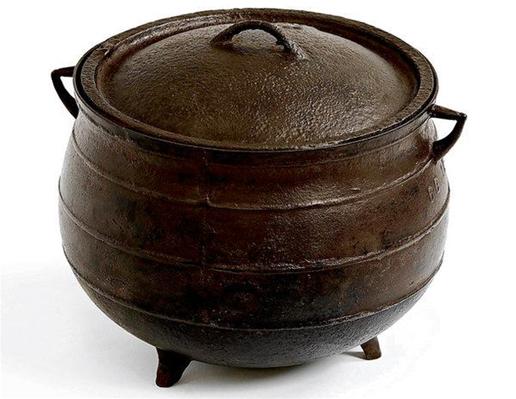
Famine Pot, 1845-9 For the Irish rural poor, the open fireplace of a small stone cottage was the locus of comfort and security. Suspended over the turf fire was a large three legged iron pot for boiling potatoes. By the 19th century these were almost always mass manufactured in a style that harked back to medieval times. They continued in use until the mid 20th century. This six gallon example came from Corelish East, Grean, Co Limerick. The three legged pot eventually became a talisman of survival. The folklorist Estyn Evans noted that during the terrible years of the Great Hunger, the potato famine of 1845-9 victims “clung to the pot when all else was gone”. Famines were far from rare in Ireland. There were perhaps 30 severe episodes between 1300 and 1800, including a disastrous failure of the potato crop in 1740. But the sheer size of the population dependent on the potato (three million or so) made the arrival in August 1845 of the fungus ‘Phytophthora infestans’, the cause of potato blight, the worst event in Irish history. That year a third of the crop was rotten and inedible. In 1846 three quarters of the crop was lost. By 1847 most of the seed potatoes had been eaten by desperate people. In the first year of the Famine the Tory government of Robert Peel responded by importing £100,000 worth of Indian meal from the US and establishing a programme of public works. The Liberal administration of Lord John Russell, which took office in 1846, continued the programme but was reluctant to interfere with market forces. A combination of laissez faire ideology, a “providential” evangelical theology that saw the Famine as God’s way of correcting the vices of the Irish, and a severe economic recession in Britain greatly limited the scale and speed of the official response. While some private organisations, notably the Society of Friends (Quakers), made heroic efforts to save lives, the ruling government refused to stop the export of food from Ireland, a source of extreme bitterness for decades to come. It was not until February 1847 that ideology and theology were set aside and public kitchens were established throughout the country to feed the starving without demanding work in return. The scheme lasted only until September, when the ruling government insisted that further relief would be supplied only at overcrowded and insanitary workhouses. This concentration of sick and starving people undoubtedly created ideal conditions for the spread of the diseases, principally typhus and relapsing fever, that killed more people than hunger alone. Misery was piled on misery as landlords, under pressure from rising taxation and falling rents, evicted tenants at a rate that rose to 100,000 a year by 1850. The Great Famine changed Ireland in ways that are still obvious. About a million people died (proportionately more than in any other known famine) and a similar number emigrated. The Irish population is still about two million short of what it was at the start of the Famine. Patterns of mass migration were reinforced. The decimation of the cottier class changed both the social structure and the prevailing culture. Those who died and left were disproportionately Irish speaking. And, most uncomfortably, a new Ireland emerged from the disaster, as Catholic beef farmers took over the vacated land. The Famine ended, but, in these respects, it has never gone away. These simple cooking pots are common around Ireland and are a nice addition to place beside your fireplace at home. Just as your ancestors did.



